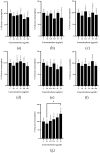Anti-Hyperglycemic Effects of Thai Herbal Medicines
- PMID: 39458809
- PMCID: PMC11511234
- DOI: 10.3390/plants13202862
Anti-Hyperglycemic Effects of Thai Herbal Medicines
Abstract
This study aims to investigate selected medicinal plants' anti-oxidative and antihyperglycemic activities to develop an effective remedy for lowering blood glucose levels and/or reducing diabetes complications. Thai medicinal plants, reported to have blood sugar-lowering effects, were selected for the study: Coccinia grandis, Gymnema inodorum, Gynostemma pentaphyllum, Hibiscus sabdariffa, Momordica charantia, Morus alba, and Zingiber officinale. Each species was extracted by Soxhlet's extraction using ethanol as solvent. The ethanolic crude extract of each species was then evaluated for its phytochemicals, anti-oxidant, and antihyperglycemic activities. The results showed that the extract of Z. officinale gave the highest values of total phenolic and total flavonoid content (167.95 mg gallic acid equivalents (GAE)/g and 81.70 mg CE/g, respectively). Anti-oxidant activity was determined using DPPH and ABTS radical scavenging activity. Among the ethanolic extracts, Z. officinale exhibited the highest anti-oxidant activity with IC50 values of 19.16 and 8.53 µg/mL, respectively. The antihyperglycemic activity was assessed using α-glucosidase inhibitory and glucose consumption activities. M. alba and G. pentaphyllum demonstrated the highest α-glucosidase inhibitory activity among the ethanolic extracts, with IC50 values of 134.40 and 329.97 µg/mL, respectively. Z. officinale and H. sabdariffa showed the highest percentage of glucose consumption activity in induced insulin-resistant HepG2 cells at a concentration of 50 µg/mL with 145.16 and 107.03%, respectively. The results from α-glucosidase inhibitory and glucose consumption activities were developed as an effective antihyperglycemic remedy. Among the remedies tested, the R1 remedy exhibited the highest potential for reducing blood glucose levels, with an IC50 value of 122.10 µg/mL. Therefore, the R1 remedy should be further studied for its effects on animals.
Keywords: Thai herbal medicine; anti-oxidant; antihyperglycemic; remedy; type 2 diabetes.
Conflict of interest statement
The authors declare no conflicts of interest.
Figures






Similar articles
-
Cytotoxic and Anti-inflammatory Activities of Medicinal Plants and Women’s Health Remedy Found in “Mahachotarat Scripture” of Thai Traditional Medicine.J Med Assoc Thai. 2016 Jul;99 Suppl 4:S211-21. J Med Assoc Thai. 2016. PMID: 29926715
-
Hibiscus sabdariffa L. polyphenolic-rich extract promotes muscle glucose uptake and inhibits intestinal glucose absorption with concomitant amelioration of Fe2+ -induced hepatic oxidative injury.J Food Biochem. 2022 Dec;46(12):e14399. doi: 10.1111/jfbc.14399. Epub 2022 Oct 18. J Food Biochem. 2022. PMID: 36259155
-
Antioxidant and Cytotoxic Effect of Barringtonia racemosa and Hibiscus sabdariffa Fruit Extracts in MCF-7 Human Breast Cancer Cell Line.Pharmacognosy Res. 2016 Jan-Mar;8(1):66-70. doi: 10.4103/0974-8490.171104. Pharmacognosy Res. 2016. PMID: 26941539 Free PMC article.
-
Antimicrobial, antioxidant activities and total phenolic content of Thai medicinal plants used to treat HIV patients.J Med Assoc Thai. 2012 Jan;95 Suppl 1:S154-8. J Med Assoc Thai. 2012. PMID: 23964459
-
Antioxidant activity and antidiabetic activities of Northern Thai indigenous edible plant extracts and their phytochemical constituents.Heliyon. 2022 Sep 23;8(9):e10740. doi: 10.1016/j.heliyon.2022.e10740. eCollection 2022 Sep. Heliyon. 2022. PMID: 36185148 Free PMC article.
References
-
- International Diabetes Federation . IDF Diabetes Atlas. 10th ed. International Diabetes Federation; Brussels, Belgium: [(accessed on 1 February 2024)]. Available online: https://www.diabetesatlas.org.
Grants and funding
LinkOut - more resources
Full Text Sources
Miscellaneous

